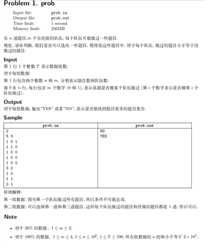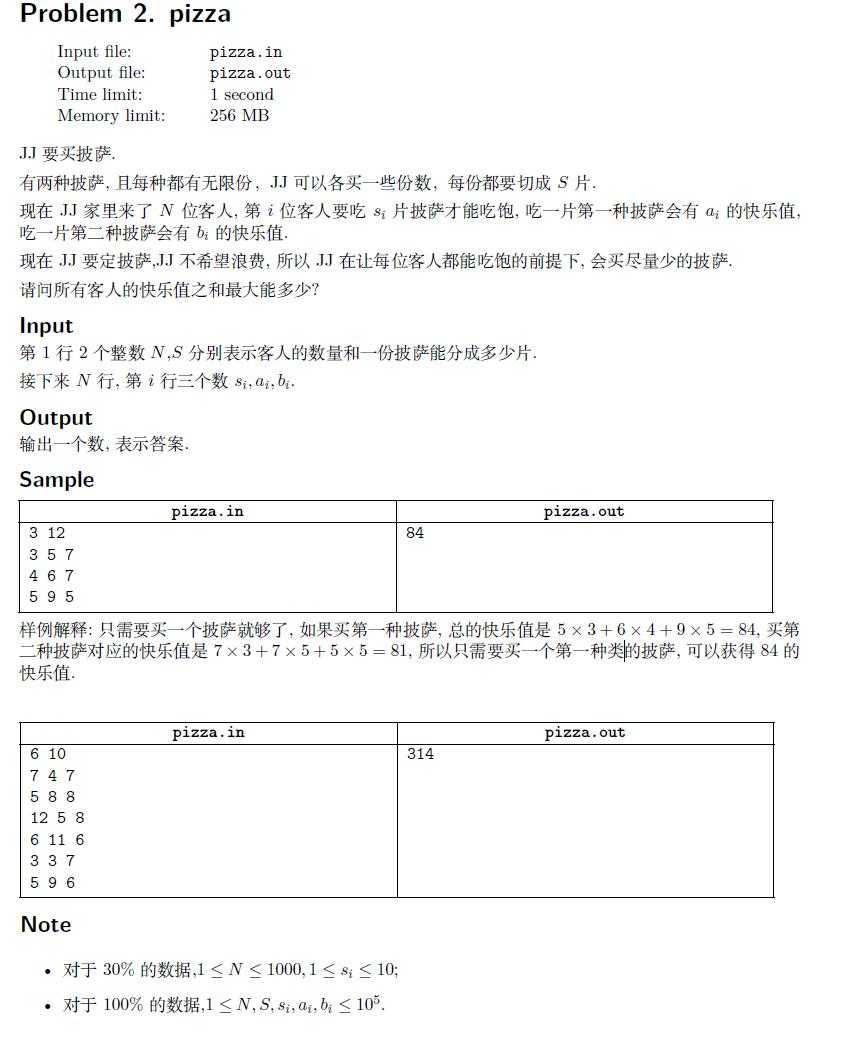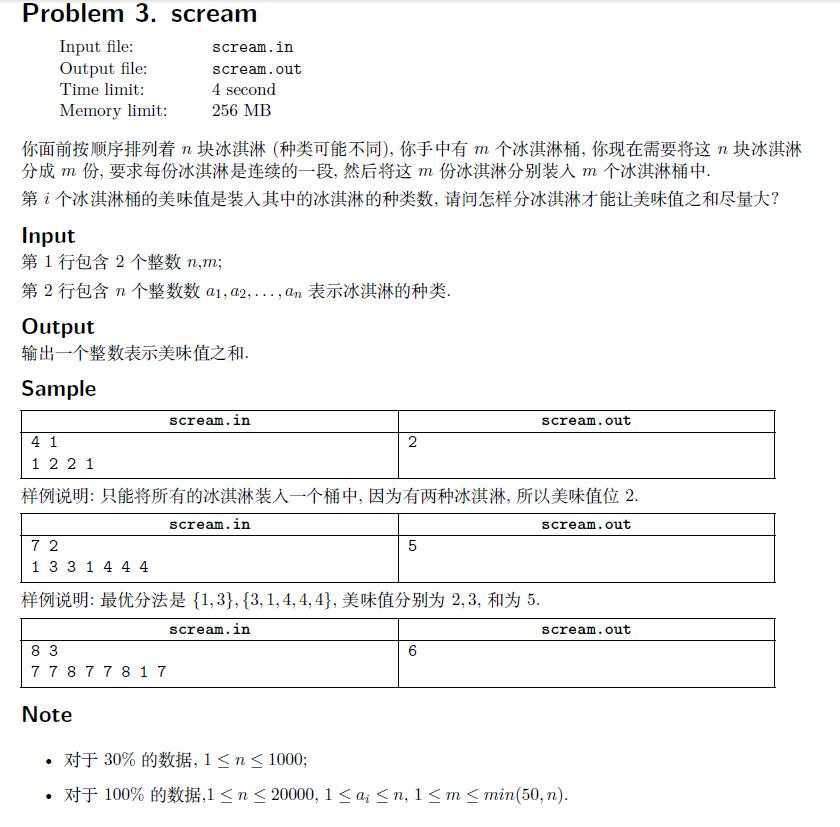8.23校内测试贪心线段树优化DP
Posted wans-caesar-02111007
tags:
篇首语:本文由小常识网(cha138.com)小编为大家整理,主要介绍了8.23校内测试贪心线段树优化DP相关的知识,希望对你有一定的参考价值。

$m$的数据范围看起来非常有问题??仔细多列几个例子可以发现,在$m<=5$的时候,只要找到有两行状态按位$&$起来等于$0$,就是可行方案,如果没有就不行。
#include<iostream> #include<cstdio> #include<cstring> using namespace std; int cnt[1<<4+1], n, m; int main ( ) { freopen ( "prob.in", "r", stdin ); freopen ( "prob.out", "w", stdout ); int T; scanf ( "%d", &T ); while ( T -- ) { memset ( cnt, 0, sizeof ( cnt ) ); scanf ( "%d%d", &n, &m ); for ( int i = 1; i <= n; i ++ ) { int t = 0; for ( int j = 0; j < m; j ++ ) { int a; scanf ( "%d", &a ); t |= a << j; } cnt[t] ++; } int flag = 0; int tot = ( 1 << m ) - 1; for ( int i = 0; i <= tot; i ++ ) for ( int j = i + 1; j <= tot; j ++ ) { if ( !cnt[i] || !cnt[j] ) continue; if ( ( i & j ) == 0 ) { flag = 1; break; } } if ( flag ) printf ( "YES " ); else printf ( "NO " ); } return 0; }

考场上想了好久,觉得这道题是个好复杂的分组背包aaa!!$qwq$,复杂度怎么可能达得到要求!!!
正解贪心...其实正确性还是显然的,因为饼数一定,我们把喜欢吃$a$饼和喜欢$b$饼的人分开,分别按他们的喜欢程度从大到小排序(喜欢程度指$a_i-b_i$或者$b_i-a_i$),我们尽量满足喜欢程度大的人的需求,可是在喜欢$a$和喜欢$b$之间有一个分界线,那里两边的人可能会在$a$和$b$中浮动,可能各选择一部分,因为我们按喜欢程度排的序,就算分界线上的人吃了不太喜欢的那种饼,也是总的快乐值亏得最少的情况。
所以我们先定一个$tot1$,是完全使喜欢$a$饼的全吃到$a$饼,此时可能$b$饼数量不够分给喜欢$b$的人,喜欢$b$中最喜欢$a$的那几个可能被迫吃到$a$,此时是一种情况。另一种则是少给$a$组分配一个,多给$b$组一个,$a$中最喜欢$b$的那几个就会被迫吃到$b$。这两种情况中更优的那个即是答案。可以证明其他情况(多给$a$两个饼少给$b$两个饼)一定会是更劣的,因为这样喜欢吃某种饼的人吃到喜欢的变少了,无用的变多了。
#include<iostream> #include<cstdio> #include<cstring> #include<algorithm> #define ll long long using namespace std; int n, S, num1, num2; struct node { int a, b, delta; ll s; node ( ll s = 0, int a = 0, int b = 0, int delta = 0 ) : s ( s ), a ( a ), b ( b ), delta ( delta ) { } } cos1[100005], cos2[100005]; bool cmp ( node a, node b ) { return a.delta > b.delta; } ll sov ( ll tot1, ll tot2 ) { ll s1 = tot1 * S, s2 = tot2 * S; ll ans = 0; for ( int i = 1; i <= num1; i ++ ) { ll qwq = cos1[i].s; qwq -= min ( qwq, s1 ); s1 -= min ( s1, cos1[i].s ); ans += 1ll * cos1[i].a * ( cos1[i].s - qwq ); if ( qwq ) { ans += 1ll * qwq * cos1[i].b; s2 -= qwq; } } for ( int i = 1; i <= num2; i ++ ) { ll qwq = cos2[i].s; qwq -= min ( qwq, s2 ); s2 -= min ( s2, cos2[i].s ); ans += 1ll * cos2[i].b * ( cos2[i].s - qwq ); if ( qwq ) { ans += 1ll * qwq * cos2[i].a; s1 -= qwq; } } return ans; } int main ( ) { freopen ( "pizza.in", "r", stdin ); freopen ( "pizza.out", "w", stdout ); scanf ( "%d%d", &n, &S ); ll s = 0, sum1 = 0, sum2 = 0; for ( int i = 1; i <= n; i ++ ) { int s, a, b; scanf ( "%d%d%d", &s, &a, &b ); int delta = a - b; if ( delta >= 0 ) sum1 += s, cos1[++num1] = node ( s, a, b, delta ); else sum2 += s, cos2[++num2] = node ( s, a, b, -delta ); } sort ( cos1 + 1, cos1 + 1 + num1, cmp ); sort ( cos2 + 1, cos2 + 1 + num2, cmp ); ll tot = ( sum1 + sum2 + S - 1 ) / S, tot1 = ( sum1 + S - 1 ) / S; ll tot2 = tot - tot1; ll tmp = sov ( tot1, tot2 ); if ( tot2 - 1 > 0 ) tmp = max ( tmp, sov ( tot1 + 1, tot2 - 1 ) ); if ( tot1 - 1 > 0 ) tmp = max ( tmp, sov ( tot1 - 1, tot2 + 1 ) ); printf ( "%I64d ", tmp ); return 0; }

首先思考暴力做法,定义$dp[i][j]$表示到第$i$个冰淇淋用了$j$个桶时可以得到的最多颜色数。$dp[i][j]=max{dp[k][j-1]+c[k+1][i]}$,$1<=k<=i-1$,其中$c[i][j]$表示从第$i$个冰淇淋到第$j$个的颜色数。
直接暴力枚举复杂度是$O(n^2)$的。考虑如何优化。
可以发现上面的$dp$转移方程中,$j$只会从$j-1$转移得到,我们可以压维。我们把$dp[k][j-1]+c[k+1][i]$看成一个值,问题其实是求一段区间内的最大值。可以用线段树,每个$j$新建一棵线段树,叶子节点储存上述值。
可是线段树怎么更新$c$数组?我们每遍历到一个冰淇淋$i$,因为当前是要把$k+1-i$装到一个桶,$i$影响的实际上是上一个$i$的颜色出现的位置到$i$,这段区间的$c$值需要$+1$,所以我们遍历到$i$时,先更新区间,然后直接查询当前最大的$dp$值即可。复杂度$O(nmlog_n)$。
【注意】因为叶子节点$k$储存的是$dp[k][j-1]+c[k+1][i]$,所以我们要更新$pre[i]+1$到$i$的$c$值,实际上是更新线段树上$pre[i]$到$i-1$这段区间。查询同理。
#include<iostream> #include<cstdio> using namespace std; int n, m, pre[20005], las[20005], a[20005]; int dp[20005][2], TR[20005*4], tag[20005*4], now; void update ( int nd ) { TR[nd] = max ( TR[nd<<1], TR[nd<<1|1] ); } void push_down ( int nd ) { if ( tag[nd] ) { TR[nd<<1] += tag[nd]; TR[nd<<1|1] += tag[nd]; tag[nd<<1] += tag[nd]; tag[nd<<1|1] += tag[nd]; tag[nd] = 0; } } void build ( int nd, int l, int r ) { tag[nd] = 0; if ( l == r ) { TR[nd] = dp[now^1][l]; return ; } int mid = ( l + r ) >> 1; build ( nd << 1, l, mid ); build ( nd << 1 | 1, mid + 1, r ); update ( nd ); } void add ( int nd, int l, int r, int L, int R, int d ) { if ( l >= L && r <= R ) { TR[nd] += d; tag[nd] += d; return ; } push_down ( nd ); int mid = ( l + r ) >> 1; if ( L <= mid ) add ( nd << 1, l, mid, L, R, d ); if ( R > mid ) add ( nd << 1 | 1, mid + 1, r, L, R, d ); update ( nd ); } int query ( int nd, int l, int r, int L, int R ) { if ( l >= L && r <= R ) return TR[nd]; push_down ( nd ); int mid = ( l + r ) >> 1, ans = 0; if ( L <= mid ) ans = max ( ans, query ( nd << 1, l, mid, L, R ) ); if ( R > mid ) ans = max ( ans, query ( nd << 1 | 1, mid + 1, r, L, R ) ); return ans; } int main ( ) { freopen ( "scream.in", "r", stdin ); freopen ( "scream.out", "w", stdout ); scanf ( "%d%d", &n, &m ); for ( int i = 1; i <= n; i ++ ) { scanf ( "%d", &a[i] ); pre[i] = las[a[i]]; las[a[i]] = i; } for ( int i = 1; i <= n; i ++ ) dp[now][i] = dp[now][i-1] + ( pre[i] == 0 ); for ( int j = 2; j <= m; j ++ ) { now ^= 1; build ( 1, 1, n ); for ( int i = 1; i <= n; i ++ ) { if ( i < j ) dp[now][i] = 0; else { add ( 1, 1, n, max ( pre[i], 1 ), i-1, 1 ); dp[now][i] = query ( 1, 1, n, 1, i-1 ); } } } printf ( "%d", dp[now][n] ); return 0; }
以上是关于8.23校内测试贪心线段树优化DP的主要内容,如果未能解决你的问题,请参考以下文章